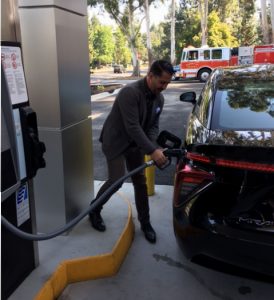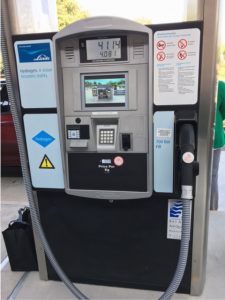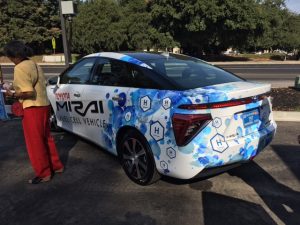Infrastructure Grows as More Fuel Cell Cars Hit the Streets
Along with plug-in electric vehicles, hydrogen fuel cell cars have a major part to play in the movement away from the internal combustion engine. The latest fuel cell cars look and perform just like “regular cars,” and you can drive one home today from a local Toyota, Honda or Hyundai dealership “if.” The “if” is the impediment to mass adoption because of the still fledgling hydrogen fueling infrastructure.

To help remedy that situation, the State of California is building 100 hydrogen fuel stations. As part of that effort, San Ramon (on the eastern side of the San Francisco Bay) now hosts station #29. It’s an attractive and spacious new facility that just opened in the sprawling Bishop Ranch industrial park, which just happens to be the headquarters of oil giant Chevron. The land for the station is leased from Toyota for $1 a year (the new station borders on Toyota’s Northern California zone office). It’s very convenient for refueling the manufacturer’s Mirai hybrid sedans, although any hydrogen-powered car is welcome.
Station #29 is one of seven stations slated for the San Francisco Bay Area in the next year (or two, the process of commissioning and building a station is long and not always predictable). Ross Koble, Toyota’s Advanced Technology PR representative, said that in the two years the Mirai has been on the road, Toyota (which pays for the fuel for leased or purchased cars, has noticed that owners appear to be extending the time between fill-ups. He thought that indicated a learning curve as owners became more comfortable with fuel cell technology and the refueling infrastructure, reducing the fear of running out of fuel.
The Ribbon Is Cut
I attended the ribbon-cutting ceremony, where a group of the people responsible for bringing this new community asset to San Ramon each spoke to an appreciative crowd.

We first heard from Bill Elrick, executive director of the California Fuel Cell Partnership, an industry/government collaboration that has worked since 1999 to expand the market for fuel cell hydrogen-powered vehicles. Elrick touted the multiple benefits of the station—environmental, economic and for energy independence. He thanked the California Air Resources Board (CARB), which has been instrumental in promoting the market for fuel cell vehicles with cash incentives on the vehicles and a regulation that encourages automakers to produce zero emission vehicles like fuel cells.
Michael Beckman, VP/Head – Key Customers & Hydrogen Fueling at Linde, the folks whose technology powers the station, thanked the assembled city and county representatives for getting the job done. “It’s tough to build in California,” Beckman said, but he was very happy with the outcome. Linde’s Ionic Compression technology is found in many applications, including the sprawling A/C Transit yard in Emeryville, which fuels 13 fuel cell buses, and a large facility at the BMW factory in Spartanburg, South Carolina. They also built the public hydrogen station in West Sacramento.
The Politicians
It’s not a community ribbon-cutting without the appropriate dignitaries, so San Ramon Mayor Bill Clarkson spoke briefly. Democratic State Senator Steve Glaser, who represents California’s 7th Senate District, praised the state’s aggressive goals and provision of incentives for alternate fuels. Republican Assemblymember Catharine Baker, who represents the 16th California Assembly District, noted the bipartisan agreement in support of this technology as it moves into cities and towns around the state.
Candace Anderson, Contra Costa County District 2 supervisor, hailed the public/private partnership that has made the air in California cleaner today. She presented a certificate of appreciation for the building of Station #29. I spoke privately with San Ramon Assistant City Manager Eric Figueroa, who was pleased to have the state-of-the-art facility in his community.
The Cars
Representing the auto industry, Dawn Mercer, National Manager, Advanced Technology Vehicles Marketing, stepped up to the microphone. She explained that Toyota has been working on fuel cells for 20 years, since the days of the first Prius, and was sanguine about the growth of fuel cell vehicles. About 2,100 Toyota Mirai fuel cell cars are tooling around California (60 percent are in the Los Angeles area, where the infrastructure is more developed than in the north) already, compared to 10 million hybrids on roads all over the world. The fuel cells are sold by only eight Toyota dealers, four in the south and four in the north.
Fuel-cell vehicles run on electricity, but unlike a plug-in electric car, which is charged from an electric source, they generate the electricity in the vehicle itself. The process involves combining the hydrogen fuel with oxygen, creating energy, with the sole byproduct being H2O—water. A Toyota Mirai can get around 312 miles on a tankful of hydrogen, and it only takes a few minutes to fill it. This replicates the experience most drivers are accustomed to at their local gas station.

The issue for early adopter hydrogen car owners has been finding a station, so placing a facility in the heart of this prosperous area is a good way to boost sales of the three hydrogen cars currently available: the Toyota Mirai and Honda Clarity midsize sedans and the Hyundai Tucson compact crossover.
Chris Weeks, director of transportation for Bishop Ranch, told Clean Fleet Report he felt San Ramon was a great spot for station #29. “There’s plenty of disposable income here, people have long commutes, and the types of people who live and work around here appreciate the new technology,” he said. Weeks drives a fuel cell Hyundai Tucson.
The sales manager for one of the eight Toyota dealers selling the Mirai, Russ Mobley, told Clean Fleet Report that some of his customers are converts from Tesla’s electric cars—some trading in their Model S and others abandoning the long line for the just-introduced Model 3 to move to an advanced technology they can drive home now. He also added that the availability of the HOV-lane sticker, which allows a Mirai driver to use the carpool lane while driving solo, is a major motivator.
Toyota executives noted that they are finding Mirai owners forming ad hoc affinity groups, sharing their experiences on social media.
The Station Process
John Kato, deputy director of the California Energy Commission, also spoke to the crowd. The California Energy Commission is tasked by state law with developing and deploying alternative and renewable fuels and advanced transportation technologies to help meet California’s goals to reduce greenhouse gas emissions and petroleum dependence in the transportation sector. The Energy Commission is responsible for building California’s network of 100 hydrogen stations; so far, they have funded 60 stations, of which 31 are currently open.

Later, Kato and I chatted about the other area of hydrogen technology that needs development. Although there are many ways to produce hydrogen fuel, it is an energy intensive process today, making it less sustainable. Kato is hopeful that the use of renewable energy generated from biomethane from waste treatment and landfills will help lead to more clean hydrogen production in California soon.
The new station’s pump looks much like a modern gas dispensing unit, with a slot to pay and a small keypad. It also features a screen with a short video explaining how to use the station. Regular patrons will presumably skip that part, but it’s good to learn to use the station properly. It’s a simple process.
The happy crowd had a chance to test drive hydrogen vehicles after the presentation, although some attendees were already proud owners. The presence of hydrogen station #29 should help more people in the Bay Area make the decision to go green with hydrogen.
Note: Michael Coates contributed to this article.
Related Stories You Might Enjoy:
Road Test: 2017 Toyota Mirai
News: 2016 Toyota Mirai Hits the Market
First Drive: 2016 Toyota Mirai
First Drive: 2017 Honda Clarity
News: Honda Introduces Production Clarity Fuel Cell
News: 2014 LA Auto Show: A Hydrogen Milestone
